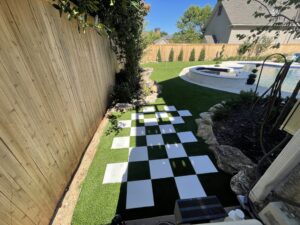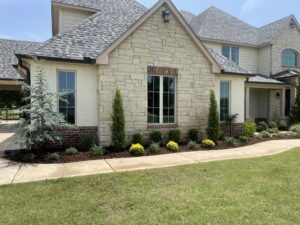Landscape is the finishing touch that completes a home or business.
The landscaping Tulsa services we offer adds depth and character to the structures and many unique plants provide the shapes and color to make the building pop.
The downside to landscaping is the initial expense, however this expense is well worth the investment as it makes your home or business stand out and draws your eye to the details and architecture of the structure.
The investment in landscaping can be a daunting expense but several things can be done to better insure the longevity of the plants making up the landscape.
This article will focus on the planting aspect of landscaping Tulsa and the three main reasons why plants die during the first 30 to 90 days following install.
The reasons include physical damage, chemical adversity, and water damage.
 Physical damage is a big reason why many plants don’t make it through the initial part of transplanting into the ground.
Physical damage is a big reason why many plants don’t make it through the initial part of transplanting into the ground.
This is due to improper handling of the plants by the nursery, delivery company, landscaper, natural weather, varmites, and insects.
Some examples of physical damage by the nursery is excessive movement of the plants, dropping the plants hard on the ground, and improper pruning.
These all affect the growth and development of the roots and structure of the plant.
The same damage can be done by delivery companies and landscapers but the landscaper can have a greater effect on the well being of the plants.
Landscapers can improperly haul plants to their final destination causing wind burn, excessive jostling, and dehydration.
Further damage can be done by improperly digging of the holes for the plants, excessive root disruption, and not properly backfilling around the plant. This is why it is so important to make sure you use the best landscaping Tulsa pros
The damage can continue when larger plants are improperly staked for stability during their first year in the ground while they root deeply into the ground.
Natural damage by wind, rain, heat, and cold also plays a part in the damage of newly installed plants trying to establish themselves in their newly created home.
However, many of the physical damages caused by the weather can be reduced if the plants are properly planted, watered, braced, and mulched.
The final cause of physical damage is by varmints and insects, such as rabbits, moles, gophers, deer, and grasshoppers.
The rabbits and deer damage the plant by excessively eating the leaves and bark which in effect is like the landscaper or nursery over pruning the plant.
The moles and gophers attack the root system of the plant and this cuts off the ability of the plant to absorb moisture and nutrients.
Finally, insects can cause extreme damage to plants by eating leaves, boring, poisoning, and sucking the nutrients from the plants.
Again many of these physical damages can be avoided or reduced by properly caring for your plants during the establishment phase of life in their new home of your beautiful landscape.
Chemical adversity causes some of the fastest and most deadly damage to plants.
Chemical damage comes from many different sources and each source has a specific purpose but if used in the wrong way or in the wrong place will cause catastrophic damage.
The chemicals come in powders, granules, liquid, and gel forms.
Some dissolve in water, some are activated by water, and others repel or are deactivated by water.
Once the damage is done there is usually no road to recovery and the plant must be removed and replaced.
Now for some examples of chemical damage that you may not even consider. The neighbor next door,or their lawn professional, sprays for weeds with glyphosate in their rock garden while the wind is blowing hard, or even extremely still, causes the vapors to drift over to your favorite rose bush contaminating it with a deadly dose of weed killer causing the rose bush to go from glam to brown in just a few days.
Yet another example is your husband gets out the power washer to clean the siding on the house and uses a new cleaner he found at the home improvement store claiming to be the fastest acting cleaner on the market.
Little did he know that cleaner has an active ingredient that is deadly to the prized Hydrangeas on the shaded side of the house.
Further, the damage can be done by using the wrong amount of chemical even though it is exactly what the plant needs to survive.
Generally, this is caused by adding too much fertilizer to the plants causing a chemical burn that kills the plant.
These are just a few examples of chemical adversity, an entire article could be written on different examples of chemical damage but for the sake of this piece we will now focus on water damage to your landscape.
Water damage is the number one cause of death to newly planted and undeveloped root systems.
Many consumers water their new plants at extreme levels causing catastrophic damage.
This over watering comes from the visual cues the plant gives during distress. An overwatered plant and under watered plant both show signs of yellowing/browning of their beautiful foliage.
As a result, the plant usually gets watered and watered some more, eventually drowning the plant. The best way to water a plant is to soak, soak, soak it then let the soil completely dry out before watering again.
This requires very little skill but does require you to get your hands dirty. Before watering your new plants check the roots for moisture. If they are dry, water them well, but if they are moist let them dry out before watering.
It is better to water fewer times for longer amounts of time than to water more frequently. Once the plant is established watering can be reduced and the need to physically check the plants is greatly reduced unless certain plants are showing signs of wilt.
Now that you know the three main ways newly installed plants die you can make better informed decisions on how to care for and protect your landscaping Tulsa investment in the beautification of your property.
This knowledge allows you to ask and test prospective landscapers on their knowledge of plants helping you make better informed decisions on who you trust to design, install, and maintain your landscaping investment.
